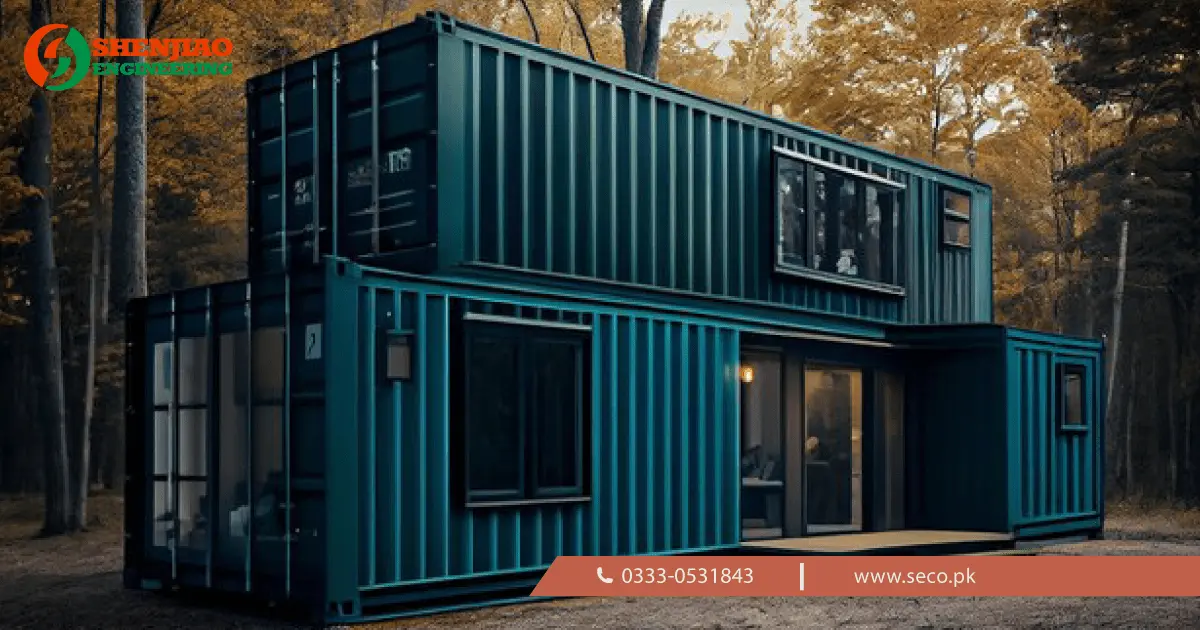Exploring Shipping Container Homes: A contemporary and eco friendly approach to living.

Shipping container homes are thus proving to be a successful modern and Eco friendly solution to housing. These stylish homes which are made from used steel container boxes are must-have for those who are looking for affordable green homes that feature simple modern design. Join us in this article and let’s look at all the aspects of shipping container homes, from what they are to why they became popular, their advantages and disadvantages.
1. Shipping container homes-what are they?
Shipping container homes are houses and dwelling constructed out of the globally recognized metal shipping containers. These are standardized to fit the normal length of a container thus measuring either 20 or 40 feet in length and are constructed from hardened and rust resistant steel. Thus, transforming such industrial units into living spaces, people can make homes which are useful and at the same time, distinctive in design.
In conjunction with construction, it is important to know that the creation of a home out of a container requires change to the overall structure of the container. This may involve such things as removal of space for window and doors, production of space for vents and holds, reinforcement for insulation, and mechanicals such as the pipes and wires. Shipping containers are versatile and portable, durable structures which can be used as one storey building for one container home or as a multi- storey one depending on the number of containers placed side by side and stacked on top of one another.
The idea of living in a steel box may not everybody’s cup of tea, but what the containers present are a unique and modern form of housing. Compact shipping container houses may be simple small cabins or spacious luxurious homes or anything in-between that the owner may wish to build.
2. Why are people choosing to build homes from shipping containers?

Here are some of the reasons why shipping container homes are rapidly becoming popular around the globe. The first is affordability. Normally constructed houses are costly to construct and maintain than using shipping containers as building structures. Compared to other basic construction materials, the price of a container may be low; in addition, while some form of groundwork may be required they are already built structures.
The second reason for a growing popularity of companies is that they are rather environmentally-friendly. As the ecological awareness grows the concept of converting old shipping containers into living spaces becomes increasingly popular among people who want to live an ecological life. Because the majority of container homes are built from recycled metal containers, they are an environmentally friendly way to go compared with traditional construction.
Last but not the least, people are flying towards tiny houses and shipping container homes due to off-grid living trend. The key reasons why many people and families are advised to opt for such homes include few of the following. If used, the shipping container can be modified to be a sustainable house leveraging on solar power and rain water harvesting technology.
3. In this article, advantages of living in shipping container homes will be discussed.
There is no doubt that one of the main benefits of the solution is cost effectiveness. Used shipping containers are relatively cheap, costing from a few thousand dollars, and the cost of converting a container home is much lower than constructing a standard home. It is rather beneficial for young families, or people who plan to have a second home because such a house is cost-effective to build.
It also overturns the notion that shipping container homes are anyhow homes since they are incredibly durable. These are receptacles designed to be used at sea, thus they are very strong and capable of standing very many abuses. The use of steel in constructing the homes gives a firm structure on the floor and walls; these homes can take any weather condition as long as the appropriate insulation and reinforcements have been put in place.
First of all, shipping container homes provide great benefit in terms of cost and time effectiveness as well as durability. Current, several containers can be piled to give a number of stories house while a single container can give out a small, simple house. Such a construction type is flexible in that sections of the home can easily be added or subtracted as the need arises.
Last but not least, container homes are environmentalism for those who cares about the environment. As it utilizes recycled material, creates little waste and requires fewer brand new resources then traditional homes, the use of used containers provides people with an environmentally friendly way to live. Most of those who opt for container homes also use such sustainable technologies as solar power, septic tanks, and energy using appliances.
4. The Shipping Container Homes challenges
Shipping container homes are great for their many advantages, but they have their fair share of challenges too. One of the biggest problems with heating is insulation. Steel makes for very efficient heat and cold conductors. A container home, however, isn’t properly insulated, which means in the summer it can be unbearably hot and in the winter it can be freezing. So, depending on environment, you might have a lot of work to insulate the container properly.
One hurdle is setting yourself up in regards to zoning and building regulations. Shipping container homes are still a new thing, and not all areas have gotten on the train just yet. Some areas may place restrictions on use of containers for residential purposes, or even require more modification and add added cost to the project. Before you get started, it’s important to make sure the local regulations allow for a container to be in your area.
However, while the containers themselves are cheap, the expense of changing and outfitting a container can probably mount up. As an example, the tools and expertise needed to cut through steel to insert windows and doors would be such specialized tools and expertise. These can cost a lot when chosen badly and included as well, including plumbing, electrical systems and insulation. When you plan to build a container home, there are some extra costs you’ll need to cover so you must budget for these.
5. Building shipping container homes
General engineering topics
To build a shipping container home starts with picking the best container. There are lots of containers that are available secondhand, but it is important to choose a container in good shape, no rust, or large damage to the structure. After selecting the container, the design of the layout is then the next step. It includes where windows, doors, and partitions will be etc and planning for electrical, plumbing, HVAC systems.
Once the design phase is finished, work can start on the modifications to the container. One of the first is cutting and reinforcing steel walls for windows and doors, insulating the container to stabilize temperature. The container is made of steel so it needs to be properly insulated so as not to condensate and keep the indoors comfortable. This might all be spray foam insulation, fiberglass, etc. For insulation that gives me adequate thermal protection.
After structural modification is completed, interior finishes can be added. Thats flooring, walls, cabinetry, and appliances included. A container home’s industrial aesthetic stays on the outside, while the inside can be made to resemble a cave of comforts, or a traditional home, with all of the modern trappings. The container is finally installed on the site, either on a foundation or directly on the ground, according to local regulations and terrain.
6. Are Shipping Container Homes Right for You?
However, as shipping container homes are not for everyone, if you are looking for a little different living solution that is affordable and eco friendly then they may be something for you to consider. For instance, whether you are a minimalist that wants to occupy as little space as possible or a designer that craves a fresh and creative building project, container homes have many ways for you to personalize and build yourself a truly one of a kind living space.
And before building your container home, it’s worth weighing the pros and cons. Initial cost savings and the notion of sustainability are appealing, but there is the problem of insulation, zoning issues, and modifications. If you are looking for a home that is a little different to the norm, and one that will really stand out from the crowd while offering you a challenge both to build and look after, a shipping container home could be just what you are looking for.
Conclusion: Opportunities of Shipping Container Homes in the Future
Shipping container homes are a modern, creative way to house that is consistent with the modern values of sustainability, affordability and minimalist living. With the rise of people wanting to live within repurposed structures, it is highly likely container homes will become more common. Like any option, they have their own set of challenges but the advantages of shipping container homes are so appealing that they are an interesting option for future homeowners.
If you’re wanting to build your own shipping container home or just curious about the trend, there is no doubt that shipping container homes are here to stay, shaking up how we think about housing in the 21st century.






One Comment